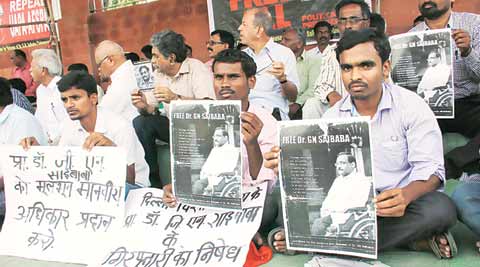Opinion Two missteps
The court has erred in denying bail to Professor Saibaba and invoking contempt law against Arundhati Roy.

 Social activists staged a protest in Nagpur Thursday, demanding Saibaba’s release on bail. (Source: Express Photos)
Social activists staged a protest in Nagpur Thursday, demanding Saibaba’s release on bail. (Source: Express Photos)
Last week, the Nagpur bench of the Bombay High Court refused to extend bail to Delhi University Professor G.N. Saibaba, who has been booked under the Unlawful Activities (Prevention) Act (UAPA) for alleged links with Maoists. The judge also issued a notice of criminal contempt to activist-writer Arundhati Roy, who, in an article published in May this year, had questioned the court’s delay in granting Saibaba bail. In both cases, the court acted harshly, and should have taken a more considered view.
The association of Saibaba — who suffers from 90 per cent physical disability due to post-polio paralysis and has already spent more than a year in jail — with the Revolutionary Democratic Front (RDF), a body that subscribes to Maoism, has been held up as evidence of his association with Maoists. In the 2011 Sri Indra Das vs State of Assam case, the Supreme Court observed that mere membership of a banned organisation is no reason to arrest or jail a person. It cited several judgments by the US Supreme Court to support its position and held that “mere membership of a banned organisation cannot incriminate a person unless he is proved to have resorted to acts of violence or incited people to imminent violence, or does an act intended to create disorder or disturbance of public peace by resort to imminent violence”. The high court’s approach towards Saibaba’s bail plea appears excessively stern, even unreasonable, against the backdrop of the apex court’s reading of the law earlier.
Roy’s controversial article is a defence of Saibaba’s right to bail. She defends his political worldview, and her own views on the conduct of the government and the police vis-a-vis Maoists are scathing. An undertrial in poor health deserves better treatment from the judiciary, she argues, and points out that individuals sentenced to life for rioting and murder have been granted bail. It is absurd to argue that Roy’s criticism could hamper the administration of the law or that it interferes with or obstructs the judicial process — the grounds on which the law of contempt is invoked. The law of contempt has been described by distinguished jurist V.R. Krishna Iyer as a “vague and wandering jurisdiction with uncertain boundaries and a suspect power to punish that lies in the hands of the prosecutor itself”. It is discretionary jurisdiction and, hence, must be exercised judiciously. As the Supreme Court observed in 1999, ironically in a case involving Roy, “the court’s shoulders are broad enough to shrug off their [critics’] comments”. The lower judiciary, too, must take criticism in its stride and guard against the illiberal tendency to stifle dissent and disagreement.


